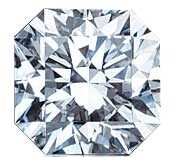#

Gabrielle’s Ideals for Flanders Cuts #
(I’ll be honest with you – I don’t have ideals for Flanders cuts! That is how rare they are! However – I’m always on the look out for them, and we love to learn about diamonds here, right? This is a generalized guide on Flanders cuts. If you are interested in one, please let us know so we can commission a custom order. We can also help you find a square radiant (1.00-1.05 ratio), which is very similar to a Flanders.)
The Flanders cut diamond is a rare and unique square brilliant cut, known for its exceptional fire, brilliance, and depth. It features eight sides, 61 facets, and a distinctive rounded-square appearance, making it a sought-after alternative to princess and cushion cuts for those who desire a perfect balance of symmetry and sparkle.
Originally developed in the 1980s in Belgium, the Flanders cut was designed to maximize light performance while maintaining a balanced, symmetrical shape. Unlike step-cut diamonds, which prioritize clarity, the Flanders cut’s brilliant facet arrangement ensures that brilliance (white light return), fire (rainbow dispersion), and scintillation (sparkle movement) are maximized.
#
1. What Is a Flanders Cut Diamond? #
A Flanders cut diamond is a modified square brilliant cut with eight sides and gently curved corners. It has a softer, less angular appearance than a princess cut while maintaining exceptional brilliance.
This cut is rarely seen in mass-produced jewelry, making it an exclusive choice for those looking for a distinctive yet high-performing diamond shape.
The ideal length-to-width ratio for a Flanders cut is 1.00–1.05, ensuring a perfectly square or nearly square look.
Why Choose a Flanders Cut Diamond?
- Unique and Rare:
Unlike princess, radiant, or cushion cuts, Flanders diamonds are not widely available, making them a distinctive choice.
- Superior Brilliance & Fire:
With 61 precision-cut facets, Flanders diamonds are optimized for maximum light return and dispersion, delivering intense sparkle.
- Excellent Durability:
The slightly rounded corners reduce the chipping risk, making them more durable than princess-cut diamonds.
- Larger Face-Up Appearance:
Due to its brilliant-cut design and square proportions, a Flanders cut can appear larger than a round or princess cut of the same carat weight.
Potential Downsides of a Flanders Cut Diamond
- Limited Availability:
Because it is a specialty cut, finding a high-quality Flanders diamond can be difficult.
- Higher Price Due to Rarity:
Since Flanders diamonds are not commonly produced, they may cost more per carat than other square shapes like princess or cushion cuts.
- Requires a Custom Setting:
Many standard ring settings are not designed for Flanders cuts, meaning you may need to opt for a custom setting to ensure a perfect fit.
#
2. The 4Cs for a Flanders Cut Diamond #
Cut – The Key to Flanders Brilliance
Flanders diamonds are designed for optimal light performance, making cut quality essential.
- Table Percentage: 58–63% ensures that the diamond has an excellent balance of brilliance and fire.
- Depth Percentage: 64–70% is preferred to ensure maximum light reflection without excessive weight retention.
- Pavilion Depth: 42–48%
- Pavilion Angle: 40–41°
- Crown Angle: 30–45° (steeper the better)
- Crown Height: 11-16%
- Girdle: 2.5–4.5%
- Girdle Thickness: Medium to slightly thick provides durability while maintaining elegance.
- Length-to-Width Ratio: 1.00–1.05 ensures the classic square appearance.
Pro Tip: A well-cut Flanders diamond should have perfectly symmetrical facets and a strong, evenly distributed light return.
Color – Keeping It Bright & Crisp
As a brilliant-cut shape, Flanders diamonds hide color well, but it’s still important to choose a grade that complements the metal setting:
- D–F (Colorless): Best for an icy-white, high-end look, especially in platinum or white gold.
- G–H (Near Colorless): The best balance between value and whiteness, appearing bright in most lighting conditions.
- I–J: Some warmth may be visible, but it pairs well with yellow or rose gold.
Pro Tip: If you prefer an ultra-white appearance, stay within D–H color grades, especially in white gold or platinum settings.
Clarity – Choosing Eye-Clean Stones
The brilliant facet structure of the Flanders cut helps mask inclusions, making it more forgiving than step cuts.
- VS1–VS2: The best value—high clarity without overpaying.
- SI1–SI2: Some SI1 stones can be eye-clean, but avoid inclusions near the center.
- VVS1–VVS2: Nearly flawless, ideal for those who want perfection.
Pro Tip: VS2 is often the best balance—eye-clean without the unnecessary premium of VVS clarity.
Carat – Maximizing Size Without Compromising Cut
Due to their brilliant faceting, Flanders diamonds appear slightly larger per carat than round diamonds but smaller than elongated shapes like ovals or marquises.
Pro Tip: A well-cut 1.50ct Flanders diamond can look nearly as large as a 1.75ct round diamond due to its light return and facet structure.
3. Additional Considerations #
Symmetry & Polish
- Symmetry: A well-cut Flanders should have perfectly aligned facets and no visible misalignment.
- Polish: Always choose Excellent or Very Good polish to ensure crisp, clean facet edges.
Fluorescence
- None or Faint fluorescence is preferred, as strong fluorescence can sometimes create a hazy appearance.
Certification
- Only buy IGI- or GIA-certified diamonds to ensure accurate grading.
Setting Considerations
- Best Settings:
- Custom prong settings to accommodate the unique octagonal shape.
- Halo settings enhance brilliance and make the diamond appear larger.
- Bezel settings offer a modern, sleek look while protecting the edges.
- Metal Choice:
- Platinum & white gold enhance brightness.
- Yellow & rose gold complement warmer tones (G–J colors).
#
Final Thoughts #
A well-cut Flanders diamond is a rare, elegant alternative to princess or cushion cuts, offering intense brilliance, durability, and a distinctive shape. If you’re looking for a square brilliant cut that stands out, the Flanders is an exceptional choice with superior fire and a bold, balanced appearance.
By following these guidelines, you can confidently select a high-quality Flanders diamond that combines rarity, brilliance, and elegance in one perfect stone.
Happy diamond hunting—may your Flanders cut diamond shine as brilliantly as its history!


